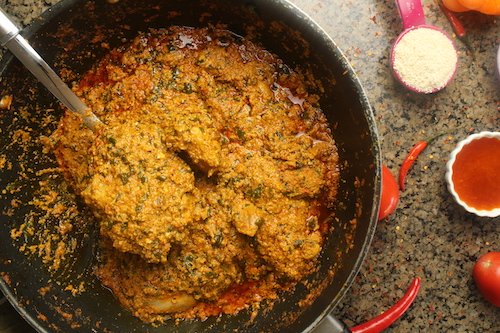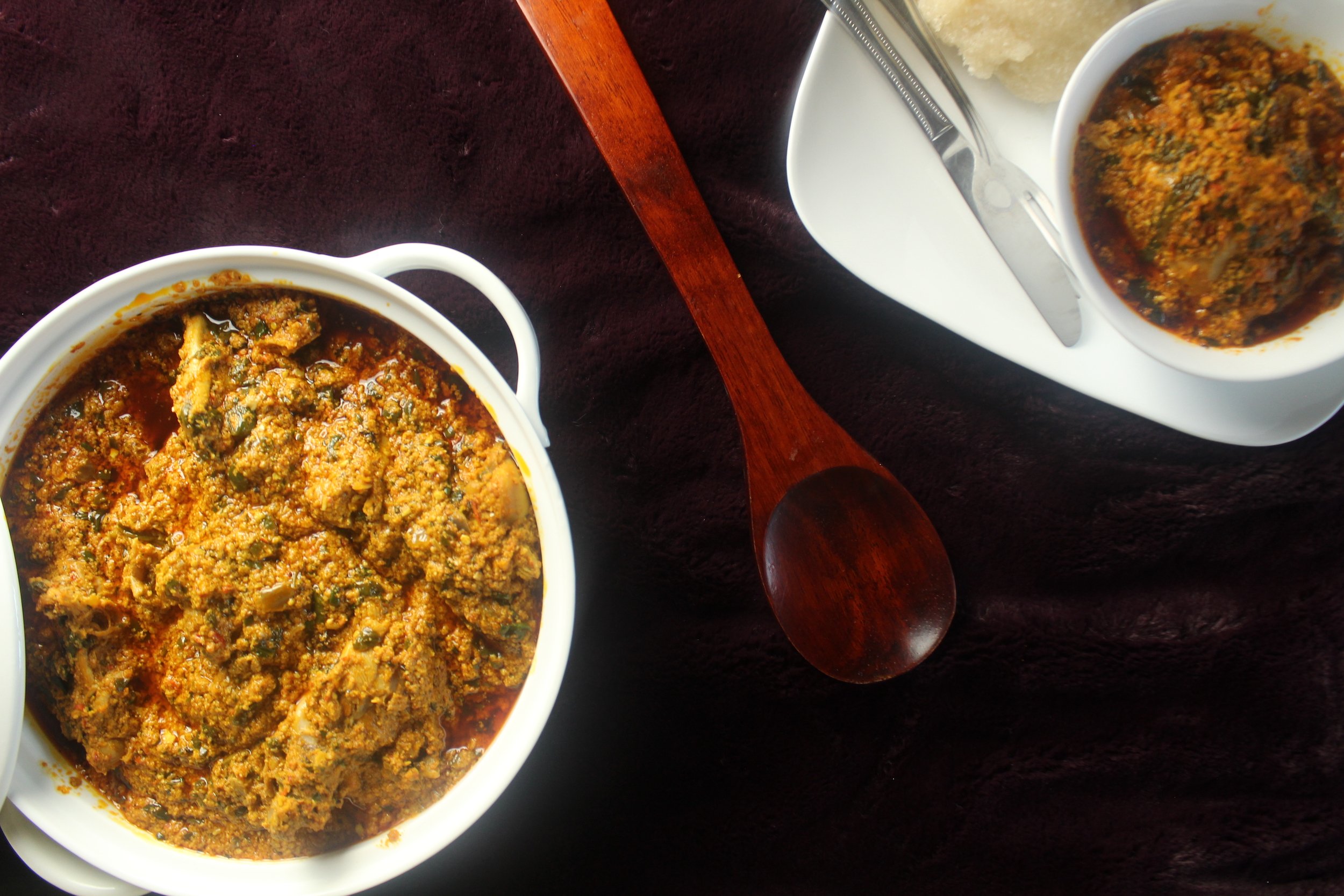Melon Soup With Tomatoes.
Melon soup or as it is best known, egusi soup is number on the list of favourite Nigerian or West African sauces. It is easy to make, ingredients you may already have or could be substituted and highly nutritious. If you have not had this before, put it on your bucket list of foods to try.
The main ingredient for cooking melon soup is egusi seeds. These are flat ovoid seeds with a tapering pointed end, milky to white in colour, very rich in protein and highly nutritious plant oil. They are the seeds of a melon plant indigenous to West Africa.
Botanically, they are called Citrullus lanatus. Melon seeds are popularly used in soups in West and Central Africa. They have a very long shelf life and are quite versatile in their uses. They used in human and livestock feeding, as well as in manufacturing.
They grow on dry land and have a light brown shell or husk covering the whitish seed. They look like the pumpkin seed in appearance and slightly larger than the sesame seeds, and are often swapped for them when not available. It is not uncommon to find families sitting around a tray full of this seed, removing the husk from them.
Other names for melon soup are agushi or guna shanu (Hausa), ikpoghiri (Itsekiri), neri niri (Ghanaians)or ibara (Congolese) and many others. You could look at a similar egusi recipe and compare both to see which suits you best. I used similar quantities of ingredients.
Nutritional Value of Melon Soup
Egusi is 30 – 40 % protein and about the same amount of oil.
The oil from this seed is cholesterol-free.
The news gets even better: 78 % of the fat is an unsaturated fatty acid, which is protective to the heart. In terms of vitamins, it contains alpha-tocopherol, a component of vitamin E that helps in maintaining smooth young skin and good fertility.
It also contains palmitic, stearic, linoleic and oleic acids essential in protecting the heart too, and a small amount of carbohydrate and calcium. No wonder the Centre for Cover Crops Information and Seed Exchange in Africa decries the gross under-researched and utility of egusi. It could greatly help to wipe off malnutrition. Now let us go over to the kitchen and start cooking.
How To Cook Melon Soup
It is always very efficient to sort out your ingredients before you commence cooking. Also, preparing some of your ingredients beforehand saves time, this is especially so if you leave in regions where electricity is not a problem. And you can store food in the fridge. But if you cannot guarantee safe storage of your prepped food beforehand then, start earlier in the day to get everything in good time.
Melon soup
|
Servings: 6 |
Prep Time: 10min |
Cooking Time: 40min |
Ingredients
- 11/2 Cup of dry and grounded egusi
- 125 ml of Palm oil
- 2 medium-sized dry fish
- 1.5 Kg of assorted Meat ( tripe, cow feet or oxtail cut bite-size)
- 6-8 Grilled chicken thigh or drumsticks
- 1 Cup stockfish pieces(optional and available in most African food shops)
- 2 medium-size onions, 1 finely chopped and the other pureed.
- 4 large roma tomatoes
- 2 large bell peppers
- 1-2 habanero pepper
- 1-2 Teaspoons grounded cayenne pepper
- 1 cup dry bitter leaves
- 2 cups of chopped spinach
- salt to taste
Method
Start by soaking your bitter leaves in warm water for at least an hour. After an hour, give it a good squeeze and rinse in cold water. Squeeze again then set aside.
While bitter leaves is soaking, transfer the tripe, cow feet and oxtail and stockfish into a pot with half of the minced onion, and salt and pepper halfway through cooking. These are though cuts and may take longer to cook. Give this about an hour to cook on medium-high when time is short. The best way to cook this is to slowly cook until tender (check out how, here, and cook beforehand to cut cooking time for this recipe).
Now, soak the dried fish in warm water for about five minutes while you get on with the next step.
Transfer onion in a blender and puree. If possible add no water, the juice from the onion is enough for what we need it for. Set aside.
Transfer the tomatoes and fresh peppers into the blender or food processor and puree, then, set aside.
Remove bones from dry fish and thorough rinse to remove any debris. Set aside.
Combine the pureed onion with the egusi until you get a paste-like consistency.
Place a heavy-based pot or wok, on a stove. When hot, pour in the oil until is hot but not smoky.
Fry the onion for about 4-5 minutes.
Pour in the tomato mixture and allow to cook for about 10-15 minutes on medium-high heat.
Stir in the tough meat and its stock, dried fish and crayfish then, continue cooking for 10 minutes
Using a spoon stir in the egusi in chunk-like bits cover the pot with the lid and allow to cook for about five minutes before adding the bitter leaves continue cooking for another 10 minutes stirring as needed so the sauce does not burn.
Stir in the chopped spinach and add salt and pepper to taste.
Cook for a further 5 minutes and serve with eba, pounded yam, rice or fufu.
Recipe provided by www.AfricanFoods.co.uk
Did you try this recipe? I will love to see, tag me on any social media platform below or share using the box. And don't forget to subscribe to newsletter if loved this recipe.
Did You Try This Recipe Share Here Or Tag Us On Instagram?
Do you have a great picture of this recipe? Please share it!
Want regular updates on African cuisines and food recipes? What about unique health information about these foods - what to eat and avoid to keep healthy from the list of African recipes available?
Fill in the form below to subscribe to our Newsletter - AfricanFoods Weekly?
Worried about spamming? We are too. We will never ever give or pass on your information to anyone else. We will only use your email address to send you your copy of our weekly newsletter. We do have a zero tolerance to spam. We subscribe to a very strict policy on the handling and use of information we gather on this site! We also get paid for affiliate links on this site. See our privacy policy for further details.
Follow us on social media:
Get Our Weekly Newsletter. Subscribe Today. It's FREE.
Subscribe to African Foods Weekly
Get African food recipes, cooking tips, and healthy eating info delivered to your inbox every week. Simply fill in your email below and click SUBSCRIBE .
(Your information will not be shared)












New! Comments
Have your say about what you just read! Leave me a comment in the box below.